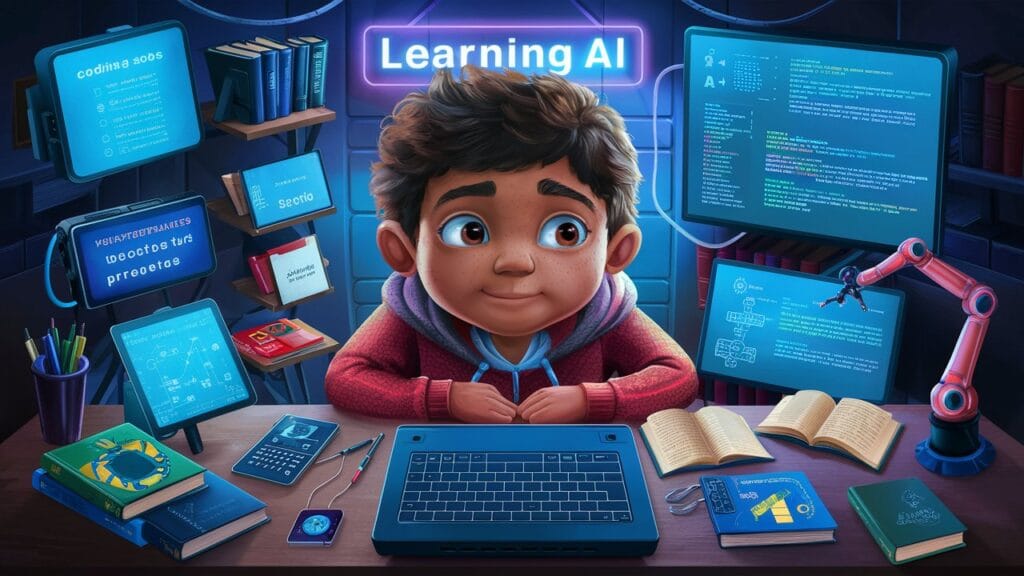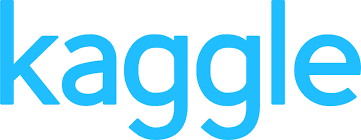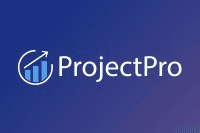
Introduction
So you want to learn Ai in (2024-25) then this post is for you. I’m going to provide you with a complete roadmap that I would follow, if I had to start over today on my Artificial intelligence journey.
If you’re intrigued by AI and want to dive in, you’re in the right place. Whether you’re a complete beginner or someone with a basic understanding of programming, this guide will provide you with a clear roadmap to start your AI journey. How to learn Ai ?
Why learn AI?

There are various reasons why learning artificial intelligence (AI) can be very beneficial, including:
Career advancement- AI skills are in demand in all industries and can create new career opportunities.
Problem-solving- AI techniques help solve complex real-world problems and improve decision-making.
Competitive advantage– Companies with AI-savvy professionals can better use technology to succeed. Automation and efficiency- AI knowledge helps implement automation strategies to increase operational efficiency.
The AI market is expected to grow to $2 trillion by 2030, making it an attractive opportunity. The early stages of the AI Revolution make it easier to enter the field, with pre-trained models from OpenAI making it easier than ever.
Code vs. Low/No-code approach

When learning AI, you can approach it from two main angles: coding and low/no-code. Each has its own advantages, depending on your goals, prior knowledge, and the specific tasks you want to achieve.
Which Approach to Choose?
- For Beginners: If you’re just starting with AI and want to explore its potential without delving into complex programming, low/no-code platforms are a great entry point.
- For Aspiring AI Professionals: If you aim to become proficient in AI and pursue advanced roles in AI development or research, a coding approach is essential to develop a deeper understanding and create more powerful models.
- Hybrid Approach: Some people start with low/no-code tools to quickly grasp AI concepts and then transition to coding for more advanced learning and customization.
In summary, coding is better for those seeking a deeper understanding and greater flexibility, while low/no-code tools are ideal for those who want to quickly apply AI solutions without getting bogged down by programming challenges.
Misunderstandings about AI
Misunderstandings about AI are common, as it is often seen as a large umbrella term with various subfields. AI, which has been around since the 1950s, includes programs with the ability to learn and reason, such as human machine learning.
Deep learning, focusing on neural networks, is another subset. Data science, on the other hand, uses both artificial intelligence and machine learning.
The first question to ask is whether you want to be a coder, as there is no right or wrong in AI. Understanding the complexities of AI is crucial for those interested in its potential applications.
Ask yourself this question
There are plenty of opportunities and pros and cons of learning AI through local NOCO tools and building custom applications. I suggest that those who want to deepen their understanding of AI should consider both paths. If AI is not for you, there are no right or wrong paths.
However, if you still want to learn AI, then I recommend starting out by checking out Botpress or Stack AI which are excellent resources. If you decide to join the Dark Side and become a coder, I will guide you through the next steps .
What makes this approach different
This approach is unique from other online resources as it focuses on the fundamentals needed to get started in artificial intelligence, data science, or any other field.
It aims to provide a technical roadmap that focuses on the core techniques, workflows, and tools needed to build applications with large language models and Lang chain.
This approach is suitable for those aspiring to become data scientists or machine learning engineers, as it helps them understand the theoretical aspects of these fields and fill in gaps in their existing knowledge.
The approach is designed to be practical and effective, making it suitable for anyone looking to advance their career in artificial intelligence.
Also read – 8 Best Ai tools for data analysts (2025)
Steps for How To Learn Ai
Step 1: Set up your environment

First step that I would focus on on my AI Journey would be to set up my work environment. Now what does this mean?
So Python is the go-to language that we have to learn, if you want to get started in AI or in data science.
Learning Python is easy and can be easily understood through online tutorials, training videos, and courses. However, there may be initial bumps in the road, as you may not have the necessary information to run code on your laptop.
To overcome this, focus on setting up an environment with an application, program, and Python installation that you are confident with.
A specific approach within FIAS Code is recommended, as many people enjoy this approach. This is the first step in getting accustomed to AI and data science.
Step 2: Learn Python and key libraries
Step two which is actually getting started with python . It’s like I said the most important language, this is going to be your tool that you’re going to build these applications in. Now if you’re new to programming at all, I would first focus on the fundamentals of programming.
Now we move on to understanding the fundamentals of Python, followed by a few libraries that are particularly helpful for data science and artificial intelligence.
These include, for example, the Numpy library, the Pandas library, and the Matteplus library, all that are tools for data manipulation and data cleansing. creating visualizations this is really your starting point for starting to work with data because in the end all AI applications , all AI tools are created from data with data.
So being able to work with data and turn raw and unstructured data into information into valuable insights that you can actually do something with is is really at the core of artificial intelligence.
Step 3: Learn Git and GitHub Basics

Now step three would be to learn the very basics of Git and GitHub, now why is that?
Some would argue that, it would be a little bit more advanced and it’s not required in the beginning.
But what I’ve found especially with artificial intelligence and also lot of example online , that the people will make that code available via GitHub .
But you have to understand kind of at the very basic, how these tools work because that allows you to easily copy and clone, is what they call it “Tutorials”.
Also read – 10 Amazing Ai tools for business- Guide for Small, Medium, and Large Enterprises
Step 4: Work on projects and portfolio
Step 4 which is working on projects and building a portfolio and for this it’s convenient if you already know how to use Git, so you can download some projects , download some code from other people and then try to reverse engineer it.
To me that really is the best way to to Learn Python. To get good to actually understand holistically what a project looks like, how people are structuring their code and trying to run it and then you don’t understand what’s going on but then trying to reverse engineer.
So it’s really like beginning with the end in mind and then trying to change things and see how that affects the different outcomes and this also provides you with an opportunity to explore what it is specifically that you like about artificial intelligence.
All the areas we’ve discussed computer vision, natural language, processing , machine learning here, you really find out, okay these are all the kinds of things that I can do and this is really what I like to do.

To learn more about data science and machine learning, one can start by exploring resources like Kaggle, which hosts machine learning competitions and offers submissions for Google. Kaggle also provides documentation and code for projects.
For those interested in exploring large language models in open AI, the GitHub repository on Lang chain experiments and YouTube channel on Ponders agents can be helpful. These resources allow users to connect with code, create YouTube bots, and ask questions about large data tables.

Project Pro is a curated library of verified and solved end-to-end project solutions in data science, machine learning, and big data. With about 3000 free recipes available, subscribers can access over 250+ end-to-end projects, complete video walkthroughs, 24/7 support, and the ability to download all the code.
This resource is particularly useful for freelance data scientists, as it provides a library of projects that can give them confidence and help them take on projects.
In addition to these resources, Project Pro also has a YouTube channel for subscribers to stay updated on their projects.
By exploring these resources, users can gain a better understanding of the field and develop skills for their future careers in data science and artificial intelligence.
Also read – 10 Best Ai courses for Software engineers
Step 5: Specialize and share knowledge

Step five, which is picking your specialization and sharing your knowledge. So right now you understand the fundamentals of python you have a work environment and some some efficient workflows that you can follow.
You also have some project experience, so now you get a little bit more clarity of what it is, that you want to do within the world of AI or data science or machine learning.
So this would be the point where you pick a focus area you specialize, you try to learn more and also what I really would recommend and what I would do is to start sharing your knowledge. So you could do this through a personal blog, you could do this through writing articles on medium or towards data science or you could even potentially like I’m doing sharing through social platforms.
By doing so you’re not only contributing to the collective knowledge on AI and data science but it’s also an essential method for you to strengthen your own learning, because in doing so in explaining Concepts that you’re working on, that you’re learning to to someone else you really start to identify the gaps within your understanding.
And this again allows you to fill in those gaps accordingly and really focus on some specialized learning versus just going through course after course after course.
Step 6: Continue to learn and upskill
Step six would be, continue to learn and upskill , because now that you have Clarity on your specialization and kind of the direction that you want to go and you also start to identify these gaps within your own understanding .
It might be time for you to for example focus on math , focus on statistics if you want to become a better machine learning engineer or a data scientist. But if you’ve decided to go with the large language model and generative AI route ,you might identify that you need some software engineering skills.
Actually really start to understand how you can work with APIs and create applications and that’s like I think the main main message that I wanna want to provide you with with regards to this roadmap.
And my Approach is that, it’s everyone’s journey is is unique and depending on what you want to do with AI there’s a specialized learning path for you.
Specifically so my goal is to really provide you with the tools and techniques to quickly get going , get your hands dirty, identify problems ,work on projects and then fill in those.
Step 7: Monetize your skills

Finally step 7- would be to monetize your skills. Now this could either be through a job, this could be through freelancing, or this could be through building a product.
But where the real Learning Happens is when there really is some pressure onto it. So it’s all fun and games when you’re trying to explore this within your free time , following some courses following, some tutorials but when it’s your boss or when it’s a client that’s breathing down your neck for the deadline that is where you really push yourself.
That is where you really get creative get resourceful and try to absorb and learn as much information as possible to just get the job done and that’s it those are the seven steps that I would take today, If I had to start over completely from scratch on my AI Journey .
Also read – 8 Free AI Tools for Students-These Are the Best!(2024)
Conclusion
And now another bonus tip that I can provide you which will make a great difference is, Surround yourself with like-minded individuals, who are on the same track, the same path as you.
Who share the same interest where you can bounce ideas off, where you can share the latest news and tips with and in order to facilitate that for you as well.
Learning AI can seem overwhelming at first, but with a structured approach, you’ll soon find yourself solving exciting problems and building impactful solutions. The key is to start small, be patient, and keep learning and experimenting.
Remember, AI is a field that thrives on collaboration and constant innovation, so don’t hesitate to reach out to others and contribute to the community.
Start your AI journey today, and who knows? You could be the next person to create the next big breakthrough in AI!
People Also Ask
1. Do I need a computer science degree to learn AI?
No, a computer science degree is not necessary. You can learn AI through self-study, online courses, and hands-on projects. A basic understanding of programming and mathematics is helpful, but anyone can start learning AI with dedication and practice.
2. What programming language should I learn for AI?
Python is the most widely used language for AI development due to its simplicity and the extensive libraries available for machine learning and deep learning, such as TensorFlow, PyTorch, and scikit-learn.
3. What are the key prerequisites for learning AI?
You need a foundation in:
- Programming (Python is recommended).
- Mathematics (linear algebra, calculus, statistics).
- Basic data analysis (using libraries like Pandas and NumPy).
4. How long does it take to learn AI?
The time required depends on your background and learning pace. For someone with a basic understanding of programming, it may take several months to a year to get comfortable with AI concepts and start building projects.
5. What are the most important concepts to learn first in AI?
Start with:
- Basic AI concepts (e.g., machine learning, deep learning).
- Supervised learning algorithms (e.g., linear regression, decision trees).
- Data preprocessing and visualization techniques.
6. What are some good resources to learn AI?
- Books: “Artificial Intelligence: A Modern Approach” by Stuart Russell.
- Courses: Andrew Ng’s “Machine Learning” on Coursera, Fast.ai’s deep learning courses.
- Websites: Towards Data Science, Kaggle, and AI-specific communities like Reddit’s r/MachineLearning.
7. Is it necessary to understand deep learning to learn AI?
No, but it is a key part of AI. Start with basic machine learning techniques before diving into deep learning. Deep learning becomes important for more complex tasks like image recognition and natural language processing.
8. How do I start building AI projects?
Begin with simple projects like:
- Image classification using machine learning.
- Sentiment analysis with natural language processing.
- A recommendation system. As you learn, try more advanced projects and contribute to open-source AI projects on GitHub.
9. What are the best AI tools for beginners?
Some beginner-friendly AI tools include:
- Scikit-learn: For basic machine learning algorithms.
- TensorFlow and PyTorch: For deep learning.
- Keras: A high-level interface for building neural networks.
10. Is AI a good career to pursue?
Yes, AI is a rapidly growing field with many career opportunities in industries like tech, healthcare, finance, and more. AI professionals, such as machine learning engineers and data scientists, are in high demand.
11. Can AI be learned without coding?
While coding is an essential part of AI development, you can learn the theoretical aspects and concepts without much coding. However, hands-on practice is crucial for deeper understanding and skill development.
12. How do I stay updated with new trends in AI?
Follow AI blogs, research papers (e.g., on ArXiv), attend conferences (e.g., NeurIPS, CVPR), and join AI communities like Stack Overflow, GitHub, and Reddit’s r/MachineLearning to stay updated.
